In the realm of upholstery, the choice of thread weight plays a pivotal role in determining the final product’s strength, durability, and overall aesthetic appeal.
Upholstery sewing machines, designed for the demanding task of working with heavy fabrics and multiple layers, require careful consideration when selecting thread weight.
Different weight threads, ranging from robust sizes like 69 to heavier options like 138, are strategically chosen based on the specific requirements of the upholstery project.
This decision not only influences seams’ structural integrity but also contributes to the visual impact, highlighting the intricate balance between functionality and design in upholstery craftsmanship.

Do You Use Different Weight Threads for Upholstery Sewing Machines?
Yes, choosing the right thread weight is crucial for upholstery sewing. The weight of the thread refers to its thickness, and it plays a significant role in the overall strength and appearance of the finished upholstery project.
For upholstery sewing machines, which are commonly used for sewing heavy fabrics and multiple layers, selecting a thread that can withstand the task’s demands is essential.
Here are some considerations regarding thread weight for upholstery sewing:
Thread Weight Options
When it comes to upholstery sewing, the thickness of the thread, often referred to as its weight, is a critical factor.
The range for upholstery threads typically spans from size 69 to 138 or even higher. Each numerical value indicates the thickness of the thread, with higher numbers representing thicker threads.
In the realm of upholstery, sizes 69, 92, and 138 are commonly used, with size 138 being especially robust and well-suited for heavy-duty applications.
Thread Strength
Upholstery threads must possess high strength and durability to withstand the demands placed on them.
Since upholstery involves sewing heavy fabrics and multiple layers, opting for threads labeled as heavy-duty or explicitly designed for upholstery ensures that the final product can endure the tension and stress inherent in such applications.
Fabric Compatibility
Different fabrics have varying weights and densities, influencing the choice of thread weight.
For heavy fabrics such as canvas, leather, or denim, thicker and more robust threads are often preferred.
On the other hand, lighter fabrics may be better suited to slightly less heavy threads to maintain a balanced and secure seam.
Needle Compatibility
The compatibility between the chosen thread and the needle is crucial for smooth and effective sewing.
Using a thread that aligns with the appropriate needle size is essential to prevent tension issues and skipped stitches.
The thread’s thickness must match the needle’s specifications employed in the upholstery sewing machine.
Seam Appearance
The thread weight significantly impacts the visual outcome of the seam. Thicker threads can produce a more pronounced and decorative appearance, adding a robust aesthetic quality to the upholstery.
Conversely, finer threads may result in a subtler finish, suitable for projects with a more delicate appearance.
Project Specifics
Consideration of the specific requirements of the upholstery project is paramount. For heavy-duty items like sofas or car upholstery, where durability is a top priority, opting for thicker threads, such as size 138, may be advantageous.
For lighter applications like decorative throw pillows, a slightly lighter thread may be more appropriate without compromising on quality.
Machine Capability
It’s essential to ensure that the chosen thread weight aligns with the capabilities of the sewing machine.
Heavy-duty sewing machines, designed explicitly for projects involving thicker fabrics and threads, provide the necessary power and stability for optimal performance. Checking the machine’s specifications ensures a seamless and efficient sewing process.
What Is 20 Weight Thread Used For?
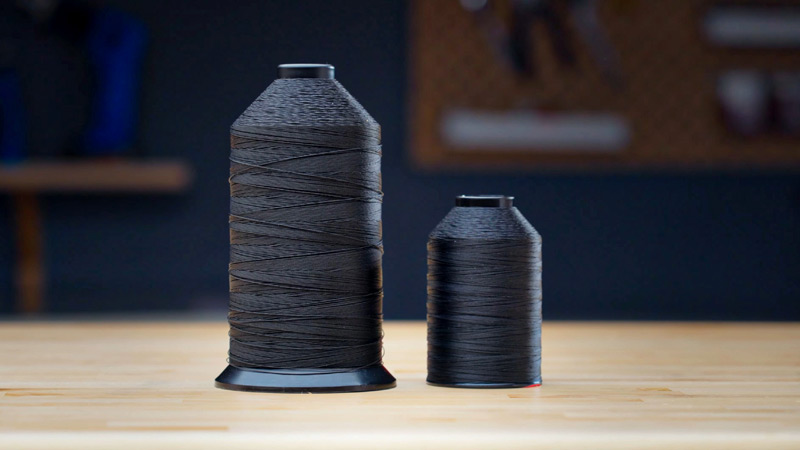
A 20-weight thread is a relatively heavy thread used in various sewing applications, particularly when a bold and prominent stitching effect is desired.
Here are some common uses for the 20-weight thread:
Decorative Stitching
20-weight thread is a popular choice for decorative stitching, as its thickness creates a bold and visually striking effect.
This makes it perfect for adding intricate embellishments to various projects, such as garments, home decor items, or quilts.
The thread’s substantial presence enhances the decorative elements, making them stand out and adding a touch of sophistication to the finished piece.
Topstitching
When it comes to topstitching, especially on heavy fabrics like denim or canvas, using 20-weight thread provides a robust and noticeable outcome.
The thickness of the thread ensures that the topstitching not only serves a functional purpose by reinforcing seams but also contributes to the overall aesthetics of the project, creating a distinctive and durable finish.
Quilting
Quilters often turn to 20-weight thread to make their quilting lines more prominent and visually impactful.
This thread weight is particularly well-suited for creating bold and intricate quilting designs.
The thicker thread enhances the texture of the quilt, turning the stitching into an integral part of the overall visual appeal and design.
Textured Fabrics
Fabrics with inherent texture, such as corduroy or unique weaves, can benefit from using 20-weight thread.
The thickness of the thread emphasizes the fabric’s texture, creating a tactile and visually interesting surface. This is especially valuable when the goal is to highlight the fabric’s character.
Artistic Embroidery
In artistic and free-motion embroidery, where creativity knows no bounds, the 20-weight thread plays a crucial role.
Its thickness allows for expressive and standout designs, turning the embroidery into a true work of art.
Artists and textile enthusiasts appreciate this thread weight for its ability to contribute to the visual impact of the embroidery.
Leatherwork
When working with leather, a material that demands strong and durable stitching, 20-weight thread is an excellent choice.
Its thickness ensures that the stitches securely hold the leather pieces together, contributing to the overall durability of the finished product. Additionally, the bold stitches can add a decorative element to leather items.
Outdoor and Heavy-Duty Projects
For outdoor gear and heavy-duty projects, where durability is paramount, the 20-weight thread comes into its own.
Whether used in the construction of tents, backpacks, or other rugged items, the thread’s strength and thickness contribute to the longevity of the seams, ensuring that they can withstand the challenges of outdoor use.
Upholstery
In the realm of upholstery, especially for furniture and other items requiring both strength and aesthetics, 20-weight thread finds its application.
The thread adds robustness to the seams, whether used for topstitching or attaching decorative elements.
This is particularly valuable in upholstery work, where the stitching not only needs to be durable but also enhances the visual appeal of the finished upholstery piece.
What Is 30 Weight Thread Used For?
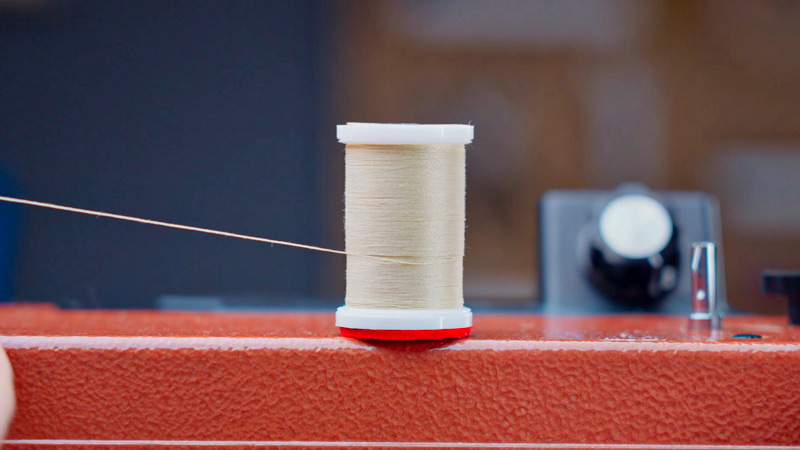
A 30-weight thread is a mid-range thread in terms of thickness, falling between finer threads like those used for general sewing and heavier threads typically used for decorative or heavy-duty applications.
Here are some common uses for 30-weight thread:
Garment Construction
30-weight thread serves as a versatile option for garment construction. It balances strength and subtlety, making it suitable for sewing together various fabrics, from lightweight cotton to medium-weight blends.
This thread weight ensures durable seams without adding excessive bulk, contributing to the overall comfort and wearability of the garment.
Quilting
Quilters appreciate the application of 30-weight thread for both piecing and quilting. Its medium thickness allows for visible stitching lines that define quilting patterns without overwhelming the overall design.
The thread’s versatility makes it well-suited for creating intricate quilting details and adding texture to the quilted surface.
Topstitching
When a more refined topstitching effect is desired compared to heavier threads, a 30-weight thread proves to be an excellent choice.
It offers the perfect balance of visibility and subtlety, making it suitable for topstitching on various fabrics, including denim and medium-weight materials.
The thread enhances the aesthetic appeal of the finished product without overshadowing other design elements.
Embroidery
In machine embroidery projects, 30-weight thread finds a sweet spot between providing sufficient coverage and allowing for intricate detailing.
It is a popular choice for embroidering various motifs and patterns, offering versatility in creating visually appealing designs.
The thread’s medium thickness ensures that the embroidery stands out without compromising on the finer details.
Home Decor Sewing
For sewing projects related to home decor, such as curtains, pillowcases, or tablecloths, 30-weight thread is a reliable choice.
It easily handles these projects’ demands, ensuring strong and secure seams. At the same time, the thread maintains a relatively refined appearance, contributing to the polished look of home furnishings.
General Purpose Sewing
The versatility of 30-weight thread extends to general-purpose sewing tasks. Whether it’s hemming, mending, or creating everyday items, this thread weight is a reliable companion.
It can seamlessly handle a variety of fabrics, providing sturdy and dependable stitching for a range of sewing applications.
Multi-Purpose Crafting
In crafting projects involving sewing, such as bag-making, accessory creation, or various fabric-based crafts, 30-weight thread offers a perfect blend of strength and visibility.
Its versatility makes it suitable for a broad spectrum of creative endeavors, ensuring that the stitching not only holds up but also enhances the overall aesthetic of the crafted item.
A blend of Strength and Versatility
30-weight thread is often the go-to choice when seeking a balance between strength and versatility.
Its ability to handle both lightweight and medium-weight fabrics makes it a valuable addition to a sewist’s toolkit.
This thread weight allows for creating projects that demand a reliable stitch without compromising on the finer nuances of design.
What Is 40-Weight Thread Used For
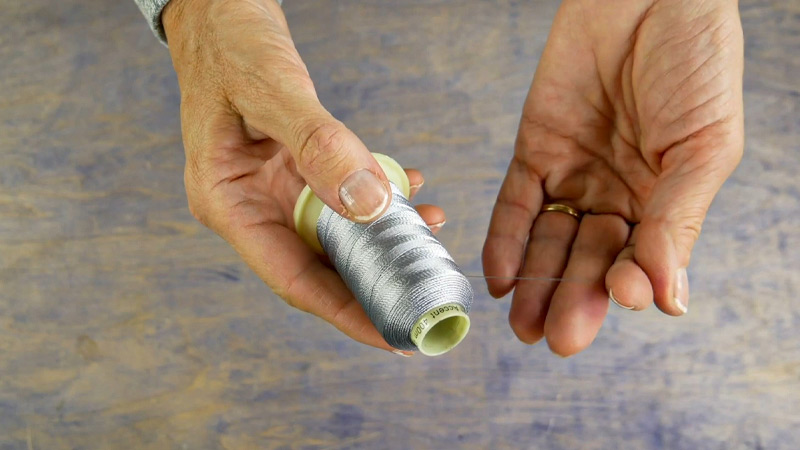
A 40-weight thread is a medium-weight thread commonly used in various sewing applications.
It falls between the finer threads used for delicate fabrics and the heavier threads used for more robust or decorative stitching. Here are some common uses for the 40-weight thread:
Garment Construction
40-weight thread is suitable for general garment construction. It balances strength and subtlety, making it versatile for fabric sewing, including cotton, linen, and lightweight blends.
This thread weight ensures that seams are secure without adding excessive bulk to the garment.
Quilting
Quilters often choose 40-weight thread for piecing and quilting. Its medium thickness provides visible stitching lines without overpowering the overall quilt design.
This thread effectively creates defined quilting patterns, adds texture to the quilted surface, and ensures a durable finish.
Embroidery
In machine embroidery, the 40-weight thread is a popular choice for various designs. It offers good coverage and is suitable for embroidering various motifs and patterns.
This thread weight balances detail and visibility, making it versatile for intricate embroidery projects.
General Sewing
40-weight thread is well-suited for general sewing tasks such as hemming, mending, and constructing everyday items.
It is a workhorse thread that can handle a variety of fabrics, ensuring reliable and consistent stitching for a wide range of sewing projects.
Appliqué
Appliqué work, where fabric pieces are attached to a background to create decorative designs, benefits from using 40-weight thread.
Its medium thickness allows for secure stitching while maintaining a neat and refined appearance on the finished appliqué.
Machine Quilting
For machine quilting projects, especially those requiring a more delicate touch, the 40-weight thread is a good choice.
It offers the necessary strength for combining quilting layers while allowing for intricate patterns and detailed stitching.
Topstitching
40-weight thread is suitable for topstitching on various fabrics, providing a balanced and refined appearance.
Whether it’s topstitching on garments, bags, or accessories, this thread weight adds a polished finish without being overly bold, making it ideal for both functional and decorative purposes.
Crafting and DIY Projects
In crafting and do-it-yourself (DIY) projects that involve sewing, the 40-weight thread is a versatile option.
It can create a wide range of items, from home decor to accessories, ensuring reliable and visually appealing stitching.
What Is 50 Weight Thread Used For?
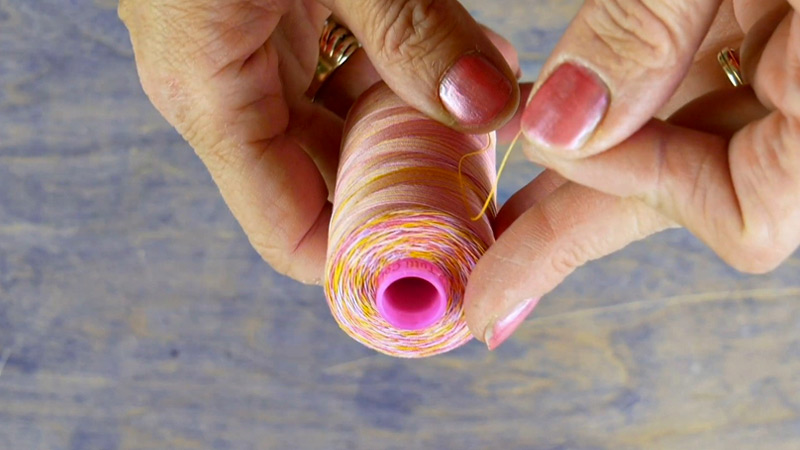
A 50-weight thread is a fine thread commonly used in sewing for various applications. Its thin diameter makes it suitable for delicate fabrics and detailed stitching.
Here are some common uses for 50-weight thread:
Piecing in Quilting
Using 50-weight thread in quilting is particularly prominent in piecing, where individual fabric pieces are joined to create quilt blocks.
Its fine diameter facilitates precise seams, ensuring that the stitched lines are subtle and virtually disappear into the fabric.
This is crucial for achieving seamless connections between quilt pieces without adding unnecessary bulk.
Embroidery
Regarding machine embroidery, the 50-weight thread is a preferred choice for detailed work. Its thin profile allows for intricate designs with a high level of definition.
This makes it well-suited for embroidery projects involving small motifs, lettering, or complex patterns where precision and clarity are paramount.
Appliqué
Appliqué’s work involves attaching fabric pieces onto a background, and 50-weight thread excels in this application.
Its thin and lightweight nature ensures that the stitches are nearly invisible, seamlessly blending with the fabric.
This contributes to a polished and refined appearance in appliqué projects, especially when working with intricate shapes and designs.
Quilting Micro-Stippling
In quilting, especially in micro-stippling techniques, where tiny, closely spaced stitches create intricate patterns, 50-weight thread shines.
Its fine thickness enables quilters to achieve densely quilted areas without compromising on the quilt’s overall flexibility or drape. This makes it a popular choice for adding intricate details to quilted projects.
Garment Construction for Lightweight Fabrics
50-weight thread is well-suited for sewing lightweight fabrics like chiffon, silk, or organza. Its thin diameter ensures that the stitches do not overpower the delicate fabric, providing a refined and elegant finish.
This makes it an excellent choice for creating garments that demand a light touch and graceful appearance.
Thread Painting
Artists and crafters often turn to 50-weight thread for thread painting, a technique where thread is used to create detailed and realistic images on fabric.
The fine thread allows for intricate detailing, making it suitable for capturing subtle nuances, shading, and fine lines in thread art projects.
Heirloom Sewing
Heirloom sewing, characterized by delicate garments featuring lace, tucks, and intricate details, benefits from the subtlety of 50-weight thread.
Its fine profile ensures that the stitches contribute to the overall delicacy of heirloom garments, allowing for the creation of timeless and finely crafted pieces.
Free-Motion Quilting
Quilters who engage in free-motion quilting, where the machine’s feed dogs are lowered, appreciate the attributes of 50-weight thread.
Its thinness enables smooth movement of the fabric under the needle, allowing for precise control over stitch direction.
This makes it an ideal choice for free-motion quilting designs that require intricacy and attention to detail.
Upholstery Thread Size Chart
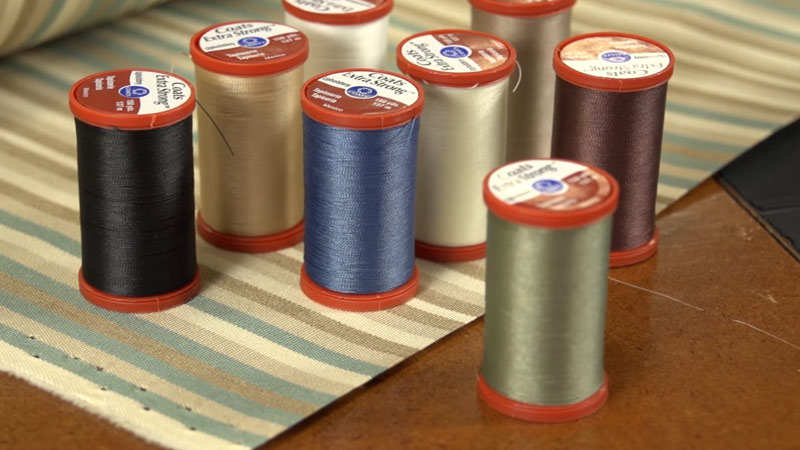
Selecting the right upholstery thread size is essential for ensuring your upholstery projects’ durability and aesthetic quality.
Upholstery thread comes in various sizes, each catering to specific fabric types and sewing machine capabilities.
To assist in making informed decisions, below is an upholstery thread size chart outlining common sizes and their recommended applications.
This guide will help you choose the appropriate thread size for your upholstery project, considering factors such as fabric weight, desired seam strength, and overall design.
Upholstery Thread Size Chart:
| Thread Size | Tex Size | Denier | Common Uses |
| 46 | 90 | 300 | Lightweight fabrics, general sewing |
| 69 | 135 | 420 | Medium-weight fabrics, standard upholstery |
| 92 | 180 | 630 | Medium to heavy fabrics, durable seams |
| 138 | 270 | 1000 | Heavy fabrics, robust upholstery projects |
| 207 | 405 | 1500 | Heavy-duty applications, outdoor upholstery |
| 277 | 615 | 2100 | Extra heavy-duty, industrial upholstery |
FAQs
Can You Use a Regular Sewing Machine for Upholstery?
Yes, you can use a regular sewing machine for upholstery, but it’s recommended to use a heavy-duty machine for better results.
What Is Upholstery Thread?
Upholstery thread is a specialized type of thread designed for sewing heavy fabrics used in upholstery projects.
What Thread Is Best for Upholstery?
The best thread for upholstery is a heavy-duty thread with a thickness suitable for the specific project.
What Thread to Use for Upholstery?
The thread to use for upholstery depends on the project’s requirements. Generally, a heavy-duty upholstery thread in sizes 69, 92, or 138 is recommended.
To Recap
Carefully considering thread weight in upholstery sewing machines is paramount for achieving both functional strength and aesthetic finesse.
The diverse range of fabrics encountered in upholstery projects demands a thoughtful selection of thread weights, with options like sizes 69 to 138 addressing varying needs.
The chosen thread weight significantly impacts the durability of seams, ensuring they withstand the stress and tension associated with heavy materials.
Simultaneously, it contributes to the visual appeal of the upholstery, with thicker threads creating bold, decorative finishes.
Striking the right balance between thread weight and project requirements is integral, underscoring the meticulous craftsmanship involved in upholstery sewing.
Leave a Reply